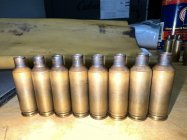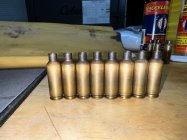The only part of the brass that'll get any work hardening is only a very very thin layer of the surface of the brass. It definitely will not work harden all the way into and through.FWIW: If you wet tumble, anneal after you tumble. The steel pins/tumbling will work harden the brass.
You are using an out of date browser. It may not display this or other websites correctly.
You should upgrade or use an alternative browser.
You should upgrade or use an alternative browser.
When to anneal
- Thread starter wywindsor
- Start date
Larry Koch
Silver $$ Contributor
Sometimes I anneal before breakfast, sometimes after. It just depends on the weather and time of year.
LVLAaron
Gold $$ Contributor
Don't be so sure.Pins don't mpact hard enough to work harden.
It hardens them enough to make a difference in the sizing / shoulder set back process.
Last edited:
shot peening in water ? noDon't be so sure.
It hardens them enough to make a difference in the sizing / shoulder set back process.
Is the Y-axis really pressure in psi? You mention 15psi spread in seating force is why I ask.
my bad Chris, it is Lbs of seating force not psi
Very little impact. The pins roll in water. The pin are not shot against the cases. The drum turns at a low RPM. If you believe the cases are work hardened that's your opinion not a fact.shot peening in water ? no
LVLAaron
Gold $$ Contributor
Very little impact. The pins roll in water. The pin are not shot against the cases. The drum turns at a low RPM. If you believe the cases are work hardened that's your opinion not a fact.
Anneal two cases.
Put one in a tumbler for an hour.
Resize them both. Tell me they are the same.
@misser anything else you want to bicker about?
you have taken things out of order . tumble wet first ,tumble corncob to dry, anneal, size , tumble corncob to remove lube, prime , powder and bullet seating , shoot ,repeat.Anneal two cases.
Put one in a tumbler for an hour.
Resize them both. Tell me they are the same.
@misser anything else you want to bicker about?
I believe it is the brass laden with pins colliding together that causes the peening of case mouths and work hardening.
Last night I wet tumbled 150 Vartargs. I separate most of the pins in a Lyman screen separator first and then dump cases in a Dillon rotary separator filled with water to remove the remaining pins inside the brass. The pins were still remaining in the Dillon separator so I went out and weighed them. There was 1# 6 oz of pins inside the cases. That equates to about 150 grains of total weight, including the case, when tumbling, falling, colliding in the Rockford tumbler. It's also probably significantly more than 150 grains since many pins must fall out in the transfer from the tumbler and first Lyman separation.
Case mouths have a serrated appearance and a peened ridge after tumbling that can be felt with a finger nail or dental pick which I remove via chamfering.
I have experienced batches of brass, all Lake City, with excessive shoulder spring back after annealing with an Ugly Annealer at same time duration and gas regulator setting. I suspect the spring back differential could be attributed it to the duration of time tumbling in pins.
Conclusion:
I think @LVLAaron that wet tumbling can work harden brass enough to affect shoulder spring back.
Last night I wet tumbled 150 Vartargs. I separate most of the pins in a Lyman screen separator first and then dump cases in a Dillon rotary separator filled with water to remove the remaining pins inside the brass. The pins were still remaining in the Dillon separator so I went out and weighed them. There was 1# 6 oz of pins inside the cases. That equates to about 150 grains of total weight, including the case, when tumbling, falling, colliding in the Rockford tumbler. It's also probably significantly more than 150 grains since many pins must fall out in the transfer from the tumbler and first Lyman separation.
Case mouths have a serrated appearance and a peened ridge after tumbling that can be felt with a finger nail or dental pick which I remove via chamfering.
I have experienced batches of brass, all Lake City, with excessive shoulder spring back after annealing with an Ugly Annealer at same time duration and gas regulator setting. I suspect the spring back differential could be attributed it to the duration of time tumbling in pins.
Conclusion:
I think @LVLAaron that wet tumbling can work harden brass enough to affect shoulder spring back.
All the responses above are good answers to your question. Here is what I do and why. I dry tumble spent casings as soon as I get home from the range. I clean the dust off them by rolling them on an towel and go right to the annealer. It is my understanding that the whole reason for annealing is to make the casings pliable for sizing so why would de-prime/size (usually one step on most dies) before you anneal? If you dry tumble with media like walnut chips, it makes sense to tumble with the spent primers in to protect the primer fire hole from getting media stuck in the fire hole. Otherwise, you really have to be extra vigilant in looking at each fire hole before priming.
I use Lapua brass and have fired many of my brass in excess of 12 times with no signs of fatigue. Just my $.02!
I use Lapua brass and have fired many of my brass in excess of 12 times with no signs of fatigue. Just my $.02!
Dave M.
F-Open Class shooter (284 win, 6dasher, 6.5-7PRCW)
I anneal my brass immediately when I get home. This is the first part of the process for me. I don’t clean my brass, other than a nylon brush once in and out of the necks after the brass has cooled from annealing.So with all the great and not so great info on the net. When do you anneal in your process. Primal rights vid shows to anneal before any other process. Right after you fire them. Other's do it after they deprime and clean. i don't get turning the brass red hot and burning the carbon on or into the brass. Same for Keith Glasscock.
right, shinny brass does nothingI anneal my brass immediately when I get home. This is the first part of the process for me. I don’t clean my brass, other than a nylon brush once in and out of the necks after the brass has cooled from annealing.
LVLAaron
Gold $$ Contributor
What do you do about the outside of the necks, and primer pocket?I anneal my brass immediately when I get home. This is the first part of the process for me. I don’t clean my brass, other than a nylon brush once in and out of the necks after the brass has cooled from annealing.
Dave M.
F-Open Class shooter (284 win, 6dasher, 6.5-7PRCW)
This is super easy to do. Don’t anneal primed brass.I've set off a live primer when annealing a 223 once. It didn't pop like I expected, just burned with a little orange flame for about a half second.
Dave M.
F-Open Class shooter (284 win, 6dasher, 6.5-7PRCW)
I have never cleaned any lube off my loaded rounds. I simply wipe them gently with a dry microfiber towel. Works great, brass has lasted 23+ firings, shot many many clean targets, and won many times using this same process.What do you use to lubricate the cases? Do you not clean it off somehow?
Dave
Right. A shiny stock also does nothing. What percentage of benchrest/Fclass shooters pay big $$ for custom paint jobs with 7 layers of high gloss automotive clear coat? 'Doing something' has nothing to do with it, does it?right, shinny brass does nothing
Dave M.
F-Open Class shooter (284 win, 6dasher, 6.5-7PRCW)
I have tested primer pocket cleaning versus uncleaned at 600 and 1000 yards and it’s just noise, it makes no difference. Because of this I stopped cleaning primer pockets 2 years ago. As for the outside of the necks, I will wipe them down really quick with a crazy cloth after every 5 firings (which I keep track of in a book, but I’ve also tested 5X fired uncleaned necks against 5X fired necks cleaned with a crazy cloth, and again it was nothing but noise. I merely do it every 5X firings for a tiny bit of piece of mind. Although, as a side note, I just started this process on my .284 brass at the end of the 2022 season. My Lapua brass for my 6 dasher has 23+ firings on the brass and I have never once cleaned the outside of the necks, and it’s an absolute hammer (see the pics of the brass necks and patina below).What do you do about the outside of the necks, and primer pocket?
Dave


Dave M.
F-Open Class shooter (284 win, 6dasher, 6.5-7PRCW)
I go to great lengths not to tumble because it has no positive effect on the target.The great lengths people go to avoid simply tumbling off lube in corn media for 30 min.
Last edited:
Similar threads
Upgrades & Donations
This Forum's expenses are primarily paid by member contributions. You can upgrade your Forum membership in seconds. Gold and Silver members get unlimited FREE classifieds for one year. Gold members can upload custom avatars.

Click Upgrade Membership Button ABOVE to get Gold or Silver Status.
You can also donate any amount, large or small, with the button below. Include your Forum Name in the PayPal Notes field.
To DONATE by CHECK, or make a recurring donation, CLICK HERE to learn how.

Click Upgrade Membership Button ABOVE to get Gold or Silver Status.
You can also donate any amount, large or small, with the button below. Include your Forum Name in the PayPal Notes field.
To DONATE by CHECK, or make a recurring donation, CLICK HERE to learn how.









